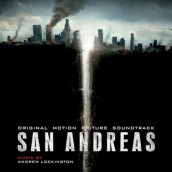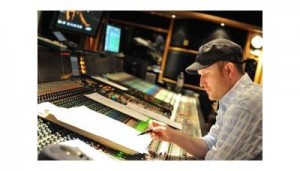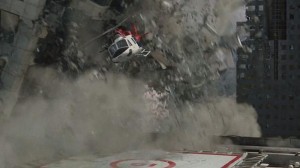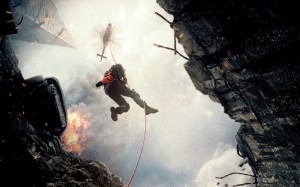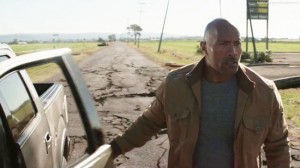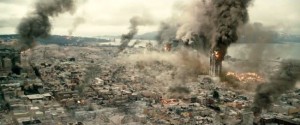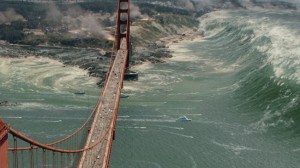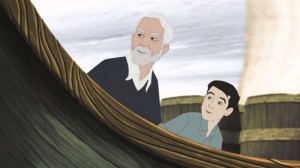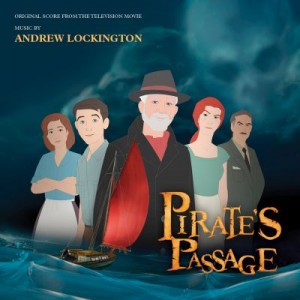This summer offers any number of musical apocalypses, from cities under siege by the laser-blasting strings and pulsing electronics of killer robots to a desert post-nuke future traversed by souped-up cars of screaming metal, tribal drumming and elegiac wastelands. But when it comes to pure, Rock-worthy symphonic muscle, Andrew Lockington might just win the symphonically sweating gold for SAN ANDREAS, a score that thrillingly jolts from a powerful, muscularly thematic ground of musical destruction and moving humanity. He’s conjured a 9.1 of raging rock guitars, anthemic themes, haunting choir, desperate rhythm and red-alert brass, all joining a veritable tidal wave of inescapable symphonic power to give thrilling presence to The Big One, that long-awaited moment when much of California falls into the seat.
For a disaster-loving Hollywood that’s already laid waste to LA with EARTHQUAKE and 2012, it’s a dollar-generating catastrophe that can’t come soon enough – at least on the screen that is. But if one man can stand up to Mother Nature, then it is The Rock (aka Dwayne Johnson), who plays Ray, a rescue pilot whose copter jets from Los Angeles to San Francisco as he tries to save his family from the worst the earth can throw at them. It’s a solid foundation of emotional peril that Lockington also uses to give a sense of movement to SAN ANDREAS that goes way beyond the orchestrally raging kind, as tender string sand piano emotion make family bonds as musically effective as the thrilling wall of themes trying to tear them apart with one special effects peril after the other.
SAN ANDREAS certainly marks The Big One when it comes to the ever-escalating scores that have come this talented composer’s way. First working alongside fellow Canadian composers Mychael and Jeff Danna as an assistant and orchestrator on numerous projects from RIDE WITH THE DEVIL to GREEN DRAGON and ANTWONE FISHER, Andrew Lockington began finding his own composing path on such small art movies as TOUCH OF PINK, SAINT RALPH and CAKE, while also garnering attention for his atmospheric werewolf score to SKINWALKERS. And while he’s continued to lend intimacy to the dual personality of FRANKIE & ALICE, the father-son time travel of I’LL FOLLOW YOU DOWN, a far bigger opportunity to play visual spectaculars arrived with JOURNEY TO THE CENTER OF THE EARTH. It’s fun, adventurous sense of kid-friendly excitement was an auspicious start to Lockington’s foray into effects-intensive, prime demographic fantasies like CITY OF EMBER, JOURNEY 2: THE MYSTERIOUS ISLAND, PERCY JACKSON: SEA OF MONSTERS 2 and recently the coming-of-age, sometimes swashbuckling tales told by an animated Donald Sutherland in the charming PIRATE’S PASSAGE. But if there’s one movie that shows that Lockington’s truly got the multiplex-swaying stuff to write on a grand playing field, than it’s his block-busting score for SAN ANDREAS, a soundtrack that thrillingly jolts from a powerful intersection of musical destruction and non-superhuman emotion.
ASSIGNMENT X: What first interested you in scoring?
ANDREW LOCKINGTON: There is a very talented French Canadian pianist/composer named Andre Gagnon. My parents took me to one of his outdoor concerts when I was 5. It was the first time I remember being emotionally moved by instrumental music in the way it really resonates in your core. The themes stuck in my head and I immediately set out to learn them by ear. They were complex, yet still melodies you could latch on to and internalize quickly. Around the same time I also fell in love with the theme song to GREATEST AMERICAN HERO by Mike Post. These two influences got me to the piano and got me playing around very early on. As I got older and continued my interest in music, songwriting was what I spent most of my time on, but good scores always affected me in the way that early concert did.
With a film score the composer doesn’t have to fit all of his/her inspiration into a three and a half minute piece. I love that a musical idea or theme can be approached in many different ways for a film score, and much like a symphony you can play with multiple variations and have themes which exist both on their own and compliment and interact with each other as well. I love the canvas a film provides for music.
AX: Could you talk about your time assisting Mychael and Jeff Danna on such scores as GIRL, INTERRUPTED, HEARTS IN ATLANTIS and THE KID STAYS IN THE PICTURE, and how it gave you your own voice as a composer?
LOCKINGTON: I am so fortunate to have had the opportunity to work with Mychael. It was a great experience on so many levels. Working with Mychael gave me the opportunity to be a part of the scoring process on so many films from beginning to end. We worked on smaller indie films and big Oscar films and even on a ballet. He was an excellent mentor and his bar for excellence is very high. He introduced me to a plethora of musical cultures that I’d never truly explored before working with him. In addition, being part of his team and getting the opportunity to participate in scoring sessions all over the world was the kind of education one just can’t get in any other way.
In the end though, the most valuable thing I took away from working with Mychael was an education on his approach to scoring films. Mychael is an intellect and a student of the world, and he researches the music for his films thoroughly before he starts writing. But while his approach is always meticulously planned and logical, he uses all of this research and knowledge as ammunition in his ultimate goal – the goal of servicing the emotional soul of the story. That overall approach is something I’ve taken with me. I’m so grateful for the experience I had with Mychael and also the education I got from the films I orchestrated for his brother Jeff Danna like THE BOONDOCK SAINTS. They’re both incredible composers and I was thrilled to see Mychael get recognized with the Oscar for LIFE OF PI.
AX: How difficult was it for you to go out on your own, let alone transition from indies to a score a film the size of JOURNEY TO THE CENTER OF THE EARTH?
LOCKINGTON: Someone always told me to never let go of the vine you’re holding until the next one is firmly in your grip. I was keeping up with writing indie films on my own and building up my portfolio of work while still assisting Mychael. It was when the projects on my own starting demanding my full attention that I knew I could no longer do both.
After a few years of indie / festival circuit films, JOURNEY TO THE CENTER OF THE EARTH was the next big step, but at the end of the day scoring a movie is still scoring a movie. The composing and storytelling skills used in writing music for film are the same set of skills regardless of the budget of the film. For JOURNEY, I was fortunate to have a music executive who believed in me enough to introduce me to the director Eric Brevig. At our first meeting, Eric and I referenced a lot of the same influences and he really responded to my ideas for the score. Most composers move into studio films by being part of a director’s team and as the director moves into the studio world, he or she hitches a ride. Because this was Eric’s first feature, he didn’t have that established relationship yet.
AX: Once you’ve gotten a box office hit like that, how did you hold onto the perception of you as a composer who could handle big, epically entertaining scores like CITY OF EMBER and PERCY JACKSON: SEA OF MONSTERS so that it’d be natural that you’d get your largest, effects-heavy film, and score yet with SAN ANDREAS?
LOCKINGTON: The box office success of a film is a lottery. I’ve worked on films I thought for sure would be box office gold and they didn’t get nearly the recognition they deserved. It’s always exciting to see how a film will perform but honestly the reward from doing the film can’t rely on it’s success at the box office, because no matter how good the film is, you’re always rolling the dice. That said, Hollywood is a business, and the success of a film is definitely measured in large part by its return at the box office. For some people it’s everything, for others the critical acclaim is more important, but no one can deny box office is usually the most important part determining the success of a film. It definitely gives studios confidence in you when your previous films have made money.
With SAN ANDREAS, I was fortunate to already have a great creative and collaborative relationship with the director Brad Peyton. Whenever we would work on the score to one of his films there were always musical ideas we would get excited about but quickly recognize weren’t appropriate to the film we were working on. We’d take those ideas and put them away to use on a future movie. SAN ANDREAS allowed us to pull a few arrows out of our quiver that we’d been excited to use for a while.
AX: You’ve certainly done your share of climactic destruction sequences with JOURNEY TO THE CENTER OF THE EARTH and JOURNEY 2: THE MYSTERIOUS ISLAND. What’s it like to turn that kind of Armageddon to Los Angeles and San Francisco?
LOCKINGTON: Terrifying. SAN ANDREAS is such a realistic feeling film I couldn’t help but think about the possibility of an earthquake happening while scoring it. Day one, I bought my earthquake kit at Costco and had a lot of water on standby just in case. It got me googling about where the faults were exactly in California – something I probably should have done prior to signing my lease since there was one directly under my house that seismologists didn’t discover until recently. I guess it wasn’t directly under my house, more like 20 feet in front of my writing room…seriously…20 feet!
It was impossible not to be thinking about the fact that this likely will happen to us in our lifetime, and huge earthquakes kill and injure hundreds if not thousands of people every year somewhere in the world. I immediately felt a responsibility to the realism of this story. I think the film affected all of the crew in that way. The film really encouraged me to think about being prepared for disasters, developing a plan with my family, having a meeting place, etc. The government advises everyone to have at least 7 days of food and water stored in a safe place in the unlikely event of an emergency. This film illicits these real feelings and these raw instincts of survival. This isn’t a superhero film. No one has any super powers. These are real characters – people like you and me finding out what they’re made of in the face of being tested. We’d all like to think we’d be brave, selfless heroes but in reality no one knows how they’d react in a survival situation until they’re in one. In the film we see examples of characters being heroic, but also examples of those who want to be brave and heroic, but are so paralyzed by fear they’re completely ineffective.
This film makes you think about those things in a real way. For that reason this is a film unlike anything I’ve ever scored, and the responsibility of scoring something so true to real life events definitely affected the musical choices I made. It always had to feel real, but it always had to tell a story as well, and that’s a tightrope we walked through the entire score.
AX: Before scoring SAN ANDREAS, did you dig into past disaster films, and scores for inspiration? And what do you think the formula is for the truly successful ones?
LOCKINGTON: For the score, we always discussed the fact that I was scoring a family’s struggle to survive more than I was scoring the natural disaster. When someone sends you a YouTube video of a guy skateboarding over a bus, it’s fascinating, but you’re not emotionally invested in it. But if they send you that same video and it’s your spouse, your child, your sibling or your friend, there’s a completely different emotional reaction to watching it. My job in this film was to make you love the characters in exactly that way. When they’re faced with death, you feel the stakes the way you would for your own family. When you see them fearing for the life of their loved ones, they need to feel like your loved ones as well. Much of the music’s heavy lifting needed to happen in the moments between the events rather than during the events themselves. In that way, it’s some of the more intimate cues in the film that were the most challenging to do, but in return the most rewarding to compose.
AX: SAN ANDREAS is most definitely a thrill ride in the tradition of “2012.” How did you want your music to put a sense of “fun” into the destruction at hand, while keeping it from crossing over into outright terror?
LOCKINGTON: It’s a thrill ride for sure, but there was never a feeling of trying to use the music to make the destruction fun. I know what you’re saying because I’ve seen it in other films, but I’d say this is more like TITANIC. You know it’s a disaster but you’re so with the characters and so inside the story you feel like you’re on the ship as it sinks. “San Andreas” is a fun ride, but the destruction is treated seriously and very realistic. We experience the quakes from the perspective of the characters and the music is very much the soundtrack playing inside their heads as they’re struggling to survive.
AX: As a resident of California, I imagine you’ve been through your share of earthquakes. What were your feelings after going through your first, and did you draw on that while composing the score?
The first earthquake I ever felt was pretty small, but it definitely surprised me. Ground stability is something we assume is a constant, and you subconsciously take for granted the ground you’re standing on is always static, or at least I did. Maybe that’s because I didn’t grow up in California, or didn’t experience an earthquake until I was an adult? I’m not sure. But it was mind blowing the first time I felt the earth shaking. Fortunately I’ve never been there for any of the big earthquakes. The biggest one I ever felt, I was sitting up in bed on the phone. All of a sudden I felt a jolt and was pushed forward so my nose was almost touching my knees (a flexibility I sadly haven’t been able to duplicate since). It was such a big jolt and loud bang I assumed a car had hit the wall behind me but other than a few swaying elements in the room, there was no evidence that anything had happened. My wife started googling “Earthquake Los Angeles” and sure enough after about 10 minutes there were reports online of a small earthquake….small. I knew then I definitely didn’t want to be there for a big one.
AX: How did you want to capture the impending suspense of The Big One?
LOCKINGTON: We purposely incorporated tension into the moments between the huge events. Brad and I discussed staying true to our approach of finding the emotion in the scene and playing the constant fear and adrenaline-filled trepidation of the characters. When you think of a dangerous series of events, it’s actually the moments between the life-threatening moments when one would actually have a chance to feel complex emotions. The music was conscious of that and works hard to keep that element present throughout the film.
AX: The Rock gets to do more acting than usual for a film with so many effects. How did you want to support his, and the other’s character’s emotions, to make them front and center while all of the chaos was going on?
LOCKINGTON: Dwayne’s acting in this film is extraordinary. He’s always been recognized as a versatile actor but he takes his character in SAN ANDREAS to places only the greatest actors can go. I forgot I was scoring Dwayne Johnson and really bought into him being “Ray”. With the best actors and characters, there are some scenes where I find it’s most important to stay out of their way emotionally. When the performance is that strong and complete, the scene is often better served to use the music to create context to what the actor is projecting. The last thing I want to do is try to re-voice what they’re already so eloquently communicating in a scene.
AX: On the other hand, The Rock is by his nature a larger-than-life actor. How did you want to play to that muscular, “American Hero” nature of his box office personality?
LOCKNGTON: I never felt a need to play the Rock as his persona, because to me he was always the character Ray. He’s a very accessible character in this movie. You immediately relate to him as a real person and he reminds you of someone you know in real life. He’s not a super-hero. The laws of gravity apply to him as much as the rest of us. So when you see his character dig deep to try to find the courage and strength to save his family, you can relate to that. The heroic theme needed to be something we could all relate to as well. It couldn’t be something too fantastic sounding or messiah-like. It had to be a melody that all of the characters could relate to. Something we might feel inside us if we were put in that position in real-life. What was great about that approach is it allowed me to use the hero theme to represent heroic moments for all of the characters. “Ray’s” heroics rub off on the people around him and by making that theme human in nature it worked on everyone from the mother to the daughter to young boy to the scientist, all of whom have their moments of bravery in the story.
AX: How did you want to capture the “whirling” nature of a hero who’s also a helicopter pilot? And how important was it to give the score that kind of sense of “traveling” momentum as he races from Los Angeles to San Francisco?
LOCKINGTON: There are films that need the music to retain the momentum in the music between set pieces. This isn’t one of them. The pace and drive of the story and the way it was written, directed, acted and edited maintains that momentum all on it’s own. That was great. It allowed me to really stay true to the moments of each scene rather than being concerned with overall pace. The nature of those scenes though definitely called for the music to be faster paced in many of them, but that quality of the story also meant I could go against the grain and write something slow and ethereal for dramatic reasons and not fear I’d be slowing down the story.
AX: You’ve definitely got the “sonic boom” going on in the score. Why do you think that chestnut is so popular in action scores, and how did you create yours?
LOCKINGTON: I work with Neil Parfitt who does a lot of sound design and modular synth programming for me. Brad and I had talked about finding the sound of destruction. He sent me some of the pre-viz sequences. One of them was a depiction of a bridge collapsing with the high-tension wires snapping. I came up with the idea of taking a piano and cutting the high-tension strings and recording the resulting sound of that. That turned into a two-day exercise of demolishing a piano in a recording studio. I remember standing in line at Home Depot with black work gloves, bolt cutters, a sledgehammer, protective facemasks, and padded blankets in my basket. The cashier looked at me suspiciously and I just shrugged my shoulders. It thought about telling him I was a musician and was destroying a piano but I’m not sure that would have helped. Anyways, I’m surprised the police weren’t at my door when I got back to the studio!
The “Earth” motif sound – this was something that came out of those recording sessions. In addition to using the string cutting and piano bashing sounds raw, we also took them and started using them as fodder for the modular synth. That sound was something that just popped out in our experimentation and we both immediately knew it was perfect for the earth motif.
AX: You’ve got the Oscar winning sound designer Per Hallberg (SKYFALL) doing the sound effects here, the nature of which in an earthquake-driven score can really rock a composer’s world, and not in a good way. How did you achieve a balance so music and effects wouldn’t overwhelm each other?
LOCKINGTON: It helped that Per’s a genius and a consummate professional. We met and screened the movie together seven months before the mix and mapped out what each other would be doing. He would send me files with their sound sketches and I would send him files with my midi demos. Per and his team are incredibly musical sound designers. Their sounds often felt like musical instruments to me and what they were doing would influence the key and tempo of what I would write. One of my favorite moments in the soundtrack is when Ray is flying towards downtown LA and you can see the buildings swaying and bending. I love how the music and sound effects work together there and how the bending sounds are like instruments in the orchestra. That type of co-operation meant we understood completely what each other were doing, and reason for attacking each scene the way we did. He was incredibly helpful in making room for the music when it needed it and vice versa. It was the kind of co-operation everyone on the post team always discusses but something that rarely happens to such perfection.
AX: SAN ANDREAS nicely straddles the earthquake-line of being a rock-guitar-percussion action score and more of a traditionally orchestral one. How did you want to combine those two natures here?
LOCKINGTON: Well one of our first discussions was that there would be no rock guitar but that the score would have that kind of edge. The fact that people perceive it is fantastic. Orchestra is such a versatile instrument, but so many scores have that element and the electronic element layered overtop of each other. The sound programmer Michael White and I set out to come up with a plan for manipulating some of our orchestral stems with filters and modular synth units to create a bridge between the organic and electronic elements. I love what we did, and it works incredibly well in the palette of SAN ANDREAS, but we both agree we just scratched the surface on a whole new world of ideas.
AX: Is it expected that brass is going to play a pretty big element in SAN ANDREAS?
LOCKINGTON: It does. Our brass section was epic. Massive. We recorded it separate from the strings and I think the string players would have gone deaf after a session of that brass section sitting right behind them. Orchestrator Nicholas Dodd came up with an idea for a unique brass combination and layout in the room to achieve the effect I was looking for. It was a complete success and we knew after our first take it was going to be perfect for the score.
AX: Do you have a particularly favorite “musical” disaster sequence in SAN ANDREAS, and if so, why?
LOCKINGTON: Probably the Hoover Dam sequence. It’s the sequence where all of the elements of the score first come together to work in harmony, and it was the first sequence I wrote in the process when I knew for sure our approach would be successful.
AX: As big and exciting as SAN ANDREAS is, two particularly intimate, and haunting scores for you were the psychologically impactful FRANKIE & ALICE and the deeply personal time travel drama I’LL FOLLOW YOU DOWN> Could you talk about working on those?
LOCKINGTON: FRANKIE & ALICE is something I scored several years ago. Halle was nominated for a Golden Globe for her performance in the film in 2010. It took several years to come out after that small theatrical run that year. I’m so glad people are finally getting a chance to see it as I’m very proud of that film and the score.
I’LL FOLLOW YOU DOWN was one of two films I scored for Richie Mehta, the other being SIDDHARTH. It’s very much a melodic, solo piano and string score and very different musically than anything people will have heard in my action / adventure films. I really enjoyed my collaboration with Richie. We’ve been friends for many years and spend so much of our times talking about films and film scores. To finally get a chance to collaborate on something with him was extremely rewarding.
AX: You’ve also done the Brad Peyton-produced and written animated movie PIRATE’S PASSAGE, whose score has just been released, and soon the film soon along with it. How do you feel it follows your numerous “boy’s adventure” scores like the JOURNEY films and PERCY JACKSON?
LOCKINTON: PIRATE’S PASSAGE is very different, both the score and the film. It’s less a story about pirate adventure and more a story about the coming of age of a young boy in the 1950′s. He befriends a mysterious older man who takes him on a journey through time to teach him about life and about being a man. Donald Sutherland plays the mysterious man who befriends the boy and their relationship immediately reminded me of my relationship with my grandfather. He had passed away just prior to me scoring the project and I had spent a lot of time reflecting on the life lessons I learned from him throughout my life. As such, I could very easily relate to their relationship in the film. Fortunately, Donald felt that was also an integral part of the story and something that the music could certainly assist in highlighting. While there are some great “adventure” moments in the film, there are many smaller and more intimate moments that didn’t call for the same massive scale of score. The smaller orchestra we had at our disposal was actually the perfect size for the score.
AX: Your fellow Canadian Donald Sutherland wears many hats in PIRATE’S PASSAGE, from voice artist to co-writer and producer. What was your interaction like?
LOCKINGTON: Donald Sutherland the actor is a Hollywood Icon, but Donald Sutherland the person is equally as extraordinary. I was introduced to him through Brad Peyton who has been friends with Donald for a number of years. He’s an incredibly wise, intelligent and knowledgeable man. He has a youthful energy, but the wisdom of a Jedi Master. He is very poetic and passionate in his views yet logical and measured in his perspectives and approach. I recently saw THE ITALIAN JOB on TV, the version where he plays a mentor to Mark Walhberg’s character. The personality of his character in that film is very much the man. He’s very gracious in helping and sharing with his fellow artists but yet manages to combine that with a quest for absolute perfection. He achieves it and once you’ve spent some time with him you realize his incredible success. It’s still only a reflection of his greatness.
I was fortunate to spend a lot of time with Donald on PIRATE’S. He was very involved and eager to participate in the scoring and mixing of the score. I learned so much from him on that film about scoring and storytelling. Those lessons will be a part of my scoring forever. It was such a gift to learn from him. He and I talked a lot about how to score great acting. It was amazing to discuss this topic with one of the greatest actors of all time and get his perspective on music in storytelling. I learned so much from those conversations and it definitely influenced my perspective on scoring this movie and certain scenes in general.
AX: What to you think makes a “pirate” score? And given that this isn’t your typical “pirate” movie, what were the challenges of achieving that kind of swashbuckling sound here?
LOCKINGTON: There are moments with that feel for sure in the PIRATE’S PASSAGE score, but as I mentioned it’s not the backbone of the score in the way it would be in the PIRATES OF THE CARIBBEAN films. I found the featuring of the fiddle, the hurdy-gurdy and the hand drums helped give that sense without needing the big orchestra in the same way. I also orchestrated the strings to make sure that my violin sections and the cello sections worked in tandem when they needed to bolster the sound, or the melody the section was playing. It gives the illusion that the sections are part of a ninety-piece orchestra when in fact it was closer to thirty-five pieces.
AX: Female chorus, something we don’t normally hear in pirate scores, is especially moving in PIRATE’S PASSAGE – as well as in SAN ANDREAS as well. What drew you to this particular “instrument” as it were?
LOCKINGTON: I work a lot with Emilie-Claire Barlow, a singer I met on the film TOUCH OF PINK almost fourteen years ago. She an incredible talent and can create so many unique personalities using her voice. She was also the featured soloist in the JOURNEY 2: THE MYSTERIOUS ISLAND score. The way we work often involves me playing or humming themes to her and her humming them back to me. I find it really helps to hear a theme sung in voice, even if it ultimately won’t be a vocal line at all. When you internalize a melody you always are imagining it with your own voice singing it in your head, so the best hooks are those that would be in the range of the human voice and also have the pauses which would mimic a person’s breath and sentence phrasing. My sessions with Emilie help me figure out if a hook is working or help me figure out how I need to change it to make it work. On PIRATE’S PASSAGE, her voice fit so perfectly and she sounded so much like the character Meg (whose singing is featured in the story) that we decided to have her voice as an element in the film.
SAN ANDREAS was different though. Instead of a female soloist we were looking for something more innocent and naive, but still beautiful and haunting. Brad and I settled on a solo boy Soprano. That was the first element we heard and knew immediately it was right for the film. From there the idea formed of having a boys choir. I knew I didn’t want low male voices chanting. I’ve done that before for other films and it’s worked well, but in keeping with the realism of this film I didn’t want to make the danger and ominous feel of the earthquake too theatrical sounding. The boys’ choir feels very spiritual and represents raw human innocence. We didn’t want it to feel religious so there’s no Latin or lyrics of any kind. I found a specific syllable that I really liked and we stayed true to that throughout the SAN ANDREAS score.
AX: You’ll next be scoring Brad Peyton’s “exorcist” thriller INCARNATE, which returns you to the horror genre for the first time since SKINWALKERS. What can we expect?
LOCKINGTON: What an awesome experience it’s been so far. We set out to create and instrumental palette completely different than anything you’ve heard from us before. Still working on it so there’s not a lot I can tell you about INCARNATE just yet, but I’m very excited for everyone to hear the score and see the movie.
AX: When do you expect The Big One? And did working on a film like SAN ANDREAS make you want to move out of California as soon as possible, or at least buy life earthquake insurance?
LOCKINGTON: SAN ANDREAS is such an honest look at earthquakes and the devastation they can cause, that even more than ever I hope “The Big One” doesn’t come in our lifetime. We’ve always said this film, as much as it’s fictitious, is based on actual future events. This will happen on some level. Hopefully in lieu of a massive series of quakes the fault will re-adjust in smaller, less damaging events, but scientists have been warning the public to prepare for the worst. Much of the world sits on fault lines like these and as we’ve seen in Japan, Chile and more recently Nepal, this is something we need to be aware of and something we need to plan for. I hope this film will help highlight the need for preparation and planning both on behalf of individuals and on behalf of our governments. Earthquake insurance is important, but a supply of water and non-perishable food to survive the aftermath is higher on the priority list for me.
People are going to love SAN ANDREAS and the physical and emotional ride it takes you on, but something tells me Costco is going to be sold out of those emergency kits in the next few weeks!
Buy Andrew Lockington’s score for SAN ANDREAS on Water Tower Music HERE, and listen to his soundtrack for PIRATE’S PASSAGE on Move Score Media HERE
Visit Andrew Lockington’s website HERE
Follow us on Twitter at ASSIGNMENT X
Fan us on Facebook at ASSIGNMENT X
Article Source: Assignment X
Article: Interview with SAN ANDREAS composer Andrew Lockington
Related Posts:




